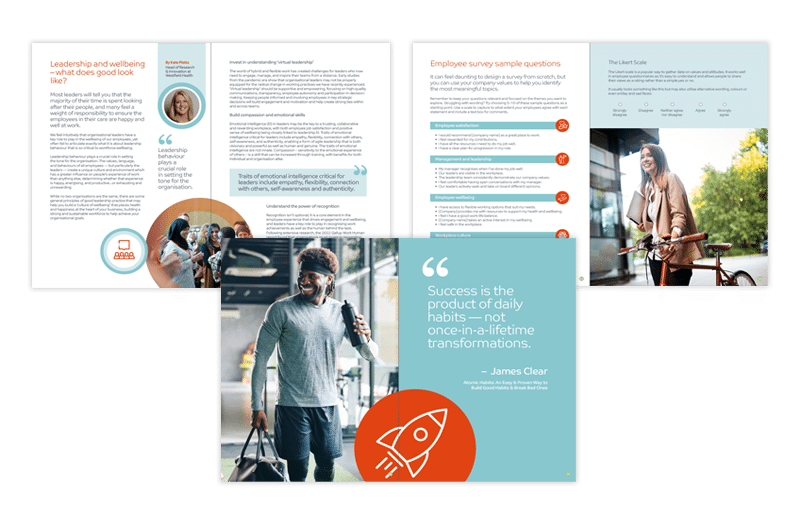Most leaders will tell you that the majority of their time is spent looking after their people, and many feel a weight of responsibility to ensure the employees in their care are happy and well at work.
We feel intuitively that organisational leaders have a key role to play in the wellbeing of our employees, yet often fail to articulate exactly what it is about leadership behaviour that is so critical to workforce wellbeing.
Leadership behaviour plays a crucial role in setting the tone for the organisation. The values, language and behaviours of all employees — but particularly the leaders — create a unique culture and environment which has a greater influence on people’s experience of work than anything else, determining whether that experience is happy, energising, and productive…or exhausting and unrewarding.

While no two organisations are the same, there are some general principles of good leadership practice that may help you build a ‘culture of wellbeing’ that places health and happiness at the heart of your business, building a strong and sustainable workforce to help achieve your organisational goals.
Invest in understanding ‘virtual leadership’
The world of hybrid and flexible work has created challenges for leaders who now need to engage, manage and inspire their teams from a distance. Early studies from the pandemic era show that organisational leaders may not be properly equipped for the radical change in working practices we have recently experienced. ‘Virtual leadership’ should be supportive and empowering, focusing on high-quality communications, transparency, employee autonomy and participation in decision-making. Keeping people informed and involving employees in key strategic decisions will build engagement and motivation and help create strong ties within and across teams.
Build compassion and emotional skills
Emotional intelligence (EI) in leaders may be the key to a trusting, collaborative and rewarding workplace, with both employee job satisfaction and positive sense of wellbeing being closely linked to leadership EI. Traits of emotional intelligence critical for leaders include empathy, flexibility, connection with others, self-awareness and authenticity, enabling a form of agile leadership that is both visionary and powerful as well as human and genuine. The traits of emotional intelligence are not innate. Compassion – sensitivity to the emotional experience of others – is a skill that can be increased through training, with benefits for both individual and organisation alike.

Understand the power of recognition
Recognition isn’t optional; it is a core element in the employee experience that drives engagement and wellbeing, and leaders have a key role to play in recognising work achievements as well as the human behind the task. Following extensive research, the 2022 Gallup Work Human report found that organisations must invest in recognition, focusing on embedding recognition in the organisational culture, educating managers about the impact of recognition and the options for providing it, and ensuring that recognition is provided in an equitable and personalised way. When leaders remember people’s birthdays, anniversaries, children’s names, and personal life events, it goes even further to making them feel valued and connected.
Remember — leaders are employees too
Finally — and although it may seem obvious — we must remember that leaders are people too, going through the same experiences of change and challenge as everyone else. Leaders must be in a strong and healthy state in order to effectively manage their function, model good wellbeing practice, and connect and engage in an authentic and undistracted way with their teams. Often the employees with the highest and most pressured workload, leaders must be given proper time and space for rest, recovery and reflection – which means work must be left at the office whilst unwell or on holiday (the rise in presenteeism and leaveism is well-documented), and expectations of being ‘always on’ should be minimised.

In leadership, what you do has far greater impact than what you say. Acting with authenticity, integrity, empathy, and self-awareness, practising transparency and good communications, recognising a job well done (as well as the person that did it), and mindful self-care are the hallmarks of a strong leader who will have positive influence on the happiness and wellbeing of those who are following.
Culture and wellbeing strategy: free e-book
Download our new Workplace Strategy Workbook to read more about the impact of culture and leadership on employee wellbeing, plus tips on how to engage your people and help them choose healthier habits.
From influencing company culture to engaging leaders and business partners, the workbook contains three chapters of guides, ideas and resources to help you create an effective wellbeing programme for your business.
